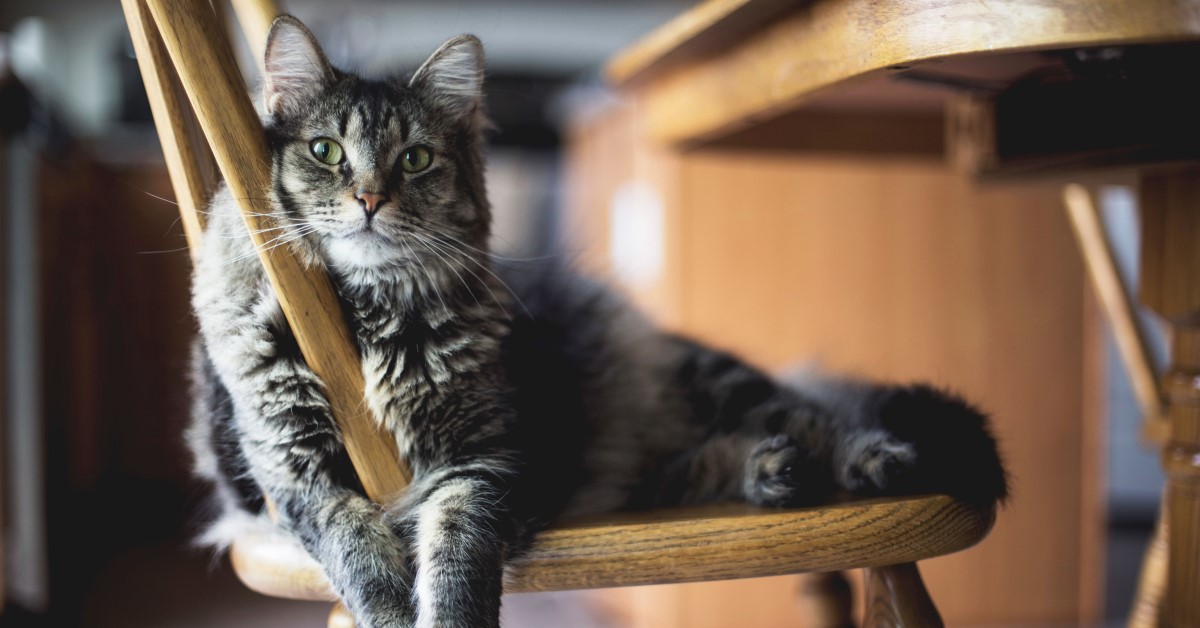Is My Cat Plotting Against Me?
Your cat is likely not plotting against you but may be trying to tell you something.

Whether they’re swatting your valuables off the table or kneading your favorite sweater, it may seem like your cat has a vendetta against you. The reason for this hostility? No one really knows. Maybe you were two minutes late for a feeding, or there was a recent vet visit. In any case, you may have it in your mind that your cat is plotting against you.
Cats are peculiar creatures and can go from warm and fuzzy one minute to cold and combative the next. Even the most devoted cat lovers will admit that these furballs are unpredictable and often erratic in mood and behavior. Is your cat a devious mastermind? Not likely, but he may be trying to communicate with you in his own way.
How Cats Communicate
You don’t have to be an animal behaviorist to figure out what your cat is saying. Felines exhibit specific behaviors that let their humans know exactly what is on their minds. Cats deploy verbal and non-verbal cues, such as a series of meows or pawing at your leg. It’s essential to pay attention to see if you can spot specific patterns. For example, a whine near the food bowl at dinner time is likely her asking for her food bowl to be filled.
Here are a few ways that cats communicate and what they could mean:
Purring
While purring may be a modern-day mystery in the world of veterinary medicine, we do have some clues that may tell us what our cats want when they purr - purring in cats occurs when the muscles of the larynx twitch, resulting in a low sound with a frequency between 25 and 100 Hertz.
Many researchers believe that cats use purring to self-soothe as this range of sound frequency has been shown to improve bone density and promote healing. Cats may have different purrs for each mood, such as hungry purrs, nervous purrs, or injured purrs.
It’s important to look at body language when identifying the meaning of a purr. If your cat looks relaxed, you can assume that the purring means he’s content. A cat may purr if he wants something, such as a meal or toy. Kittens may purr at just a few days old to let their mothers know where they are or as a bonding tool.
Meowing
Cats commonly express their emotions through meowing. Your cat may produce several different types of meows, such as murmur patterns, vowel patterns, articulated patterns, or strained intensity patterns. Your cat may meow as a form of greeting when you arrive home or as a way to get attention. Cats with cognitive impairment may meow when they are disoriented. Some feline breeds, such as Siamese cats, are known to meow more frequently than other domestic breeds.
Other Vocal Communication
Cats use dozens of different sounds to communicate with their humans, such as growling, hissing, or spitting noises. These types of sounds likely indicate that your cat is frightened or annoyed. If you fail to remove the stressor, the cat’s irritability may continue to rise, and the intensity of these vocal communications may increase. Cats may also yowl when in distress or pain.
Chatting is also a common sound that many cats make. This sound is meant to mimic the call of prey, and felines often use it to confuse the animal in question long enough so they can pounce. You may notice your cat chattering while peering out the window at a bird or while quietly watching a squirrel from across the yard.
Body Language
Your cat’s body language may also tell you what he’s feeling. Start by looking at his facial expressions. Happy cats often have soft expressions with little to no tension in the eyebrows, while alert or fearful cats may appear tense. Cats also tend to make eye contact with humans, which could make you believe that they are plotting against you. While “starring” may seem threatening, this action usually indicates that your cat simply wants your attention.
Also, pay attention to your cat’s ears. Cats have 32 muscles in each ear and can control their position based on their emotions. Cats feeling content will usually have their ears facing forward, while cats that are fearful or alert may have their ears slightly down. Take a look at your cat’s tail position. If her tail is held high in the air, she may be feeling friendly. When a cat is feeling threatened or uncomfortable, it may tuck its tail alongside its body.
The Wildcat Connection
So, now that we’ve explained how cats communicate, you may think you’re in the clear. However, research published in a psychology journal says otherwise. Researchers compared the personalities of domestic house cats to those of wildcats. They were similar in terms of agreeableness, extraversion, openness, neuroticism, and conscientiousness. The study showed that domestic house cats have similar personalities to African lions with high inclinations towards impulsiveness, dominance, and neuroticism.
So What Does It All Mean?
While you’ll never know for sure if your cat is plotting against you, the odds are that you’re safe against any advances your feline “frenemy” may make. It’s important to understand the personality characteristics of your pet and learn to understand his wants and preferences so that you can live harmoniously together.
Ready to start saving money on pet wellness care?
Then take a look at Mint Wellness, the pet wellness plan that provides fast reimbursement on routine pet care. Save on vaccinations, wellness exams, preventatives, dental, and more!
Learn More


